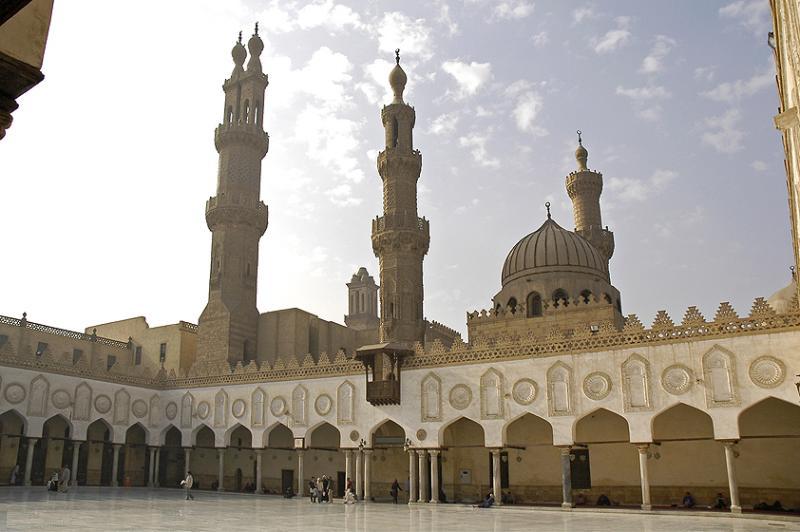Egyptian researcher Mai Hawas has found a novel way of putting a light on Egypt’s rich Islamic heritage. She is linking the architectural designs of hundreds of mosques with the faith of their designers.
Hawas, the author of “The Influence of the Islamic Sects on the Architecture of Mosques,” said that, in addition to being places of prayer and worship, mosques are studies in art, history and the beliefs of their builders. In Egypt, which has a history of both Sunni and Shia caliphates, the past can live on through the ancient blocks of its mosques.
“The interior designs of the mosques, their exteriors and their making speak volumes about the faith of those who built them and the time of their construction,” said Hawas, a researcher studying the effects of Islamic schools of thought on mosque architecture. “Mosques built by Sunnis are in no way similar to those built by Shias.”
Cairo has been called a City of a Thousand Minarets. There are approximately 130,000 mosques in Egypt, most of the oldest are in Cairo. Each house of worship has a story behind its construction, a philosophy of construction and its own special internal and external design.
Hawas, who visited dozens of mosques in Iraq and Iran, said he found something in common between the mosques she toured in those two predominantly Shia countries and mosques in Egypt, especially those built during the Fatimid era (969-1171).
The Fatimid rulers, who were Shias, constructed many mosques in Egypt, most of them carrying the rulers’ fingerprints. Some of the mosques they built, such as the al-Aqmar Mosque in Cairo, reveal a lot about the builders.
Opened in 1125, al-Aqmar Mosque has brazen Shia features. Above its main entrance is a pierced medallion where the names of the Prophet Mohammad and his cousin and son-in-law Ali — the first imam of the Shias — are inscribed.
The names of Mohammad and Ali are not the only distinguishing marks on some of Egypt’s most famous mosques. Shias, Hawas said, did not put too much emphasis on the height of their mosques, unlike Sunni architects who followed.
“This is why the minarets above the mosques built during the Fatimid era are not very high,” she said. “Nonetheless, most of the mosques have huge entrances that inspire respect and awe.”
Shia mosques are pieces of visual art, boasting distinguishing ornaments and colours. Mosques built in Egypt by the Fatimid rulers are no exception.
The place where the imam stands to lead the prayer inside the mosques, known as the mihrab, is often decorated with a vibrant mosaic of different types and colours. The vaulted iwan — space that opens onto a courtyard — usually has a distinctive square shape, unlike the rectangular one in Sunni mosques.
Shia mosques also tend to have more than one entrance; Sunni mosques usually have a single main entrance.
“Apart from other distinguishing features, these can easily give mosque visitors clues into the time of the construction of the mosques as well as the faith of their visitors,” said architect Tarek Waly, founder of the Tarek Waly Centre for Architecture and Heritage. “The sects that prevailed at different historical stages deeply affected mosque construction and the final designs of the mosques.”
Al-Aqmar Mosque has the most distinctive Shia design of all the mosques built during the Fatimid era.
Many other mosques from the period display more ambiguous designs, melding Shia design features with more traditional Sunni ones, part of a move to placate Egypt’s Sunni majority.
This can easily be seen in the construction of al-Azhar Mosque in 972. Although it was the first mosque to be constructed during the Fatimid rule of Egypt, al- Azhar’s design bears scant Shia architectural design features.
Sunnis, Hawas said, were more interested in the exterior designs of their mosques. This is why most of Egypt’s oldest Sunni mosques have awe-inspiring designs from outside but appear austere inside, in stark contrast to mosques built by Shias.
“The Sunnis were more into towering buildings, which is why most of the minarets of Sunni mosques are very high,” Hawas said. “Most Sunni mosques are also built on eight major pillars, the same number of the angels carrying God’s throne as mentioned in the holy Quran.”
These diverse mosque designs and the ease with which ordinary citizens deal with them attest to Egypt’s special nature — a country that absorbed all the various religious influences and turned them into its own special identity.
Sultan Hassan Mosque, in southern Cairo, is the most obvious example of Sunni design. With its towering minaret, high walls and austere interior, the mosque — built 1356-1363 — is the most representative of the Mamluk period, which came after the Fatimid era.
The mosque contains chambers where the followers of different Islamic schools of thought could gather to study, additional proof of Egypt’s multifaith and tolerant nature.
“This is actually what makes Egypt a great country,” said Nader Abdel Dayem, professor of Islamic antiquities at Ain Shams University. “Egyptians have known tolerance even before the term was coined.”








































admin in: How the Muslim Brotherhood betrayed Saudi Arabia?
Great article with insight ...
https://www.viagrapascherfr.com/achat-sildenafil-pfizer-tarif/ in: Cross-region cooperation between anti-terrorism agencies needed
Hello there, just became aware of your blog through Google, and found ...